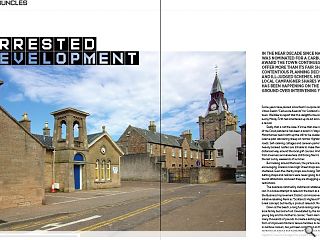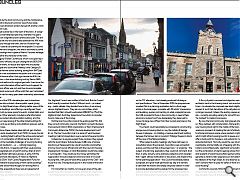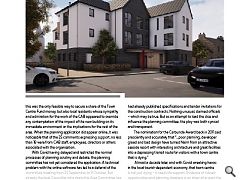Nairn: Arrested Development
18 Jan 2021
In the near decade since Nairn was nominated for a Carbuncle award the town continues to offer more than its fair share of contentious planning decisions and ill-judged schemes. Here a local campaigner shares what has been happening on the ground over intervening years.
Some years have passed since Nairn’s surprise listing in the Urban Realm “Carbuncle Awards” for Scotland’s most dismal town. We’dlike to report that this delightful tourist town on the sunny Moray Firth had smartened up its act and was enjoying a revival.
Sadly, that is not the case. It’s true that one consequence of the Covid pandemic has been a boom in ‘staycations’. Motorhomes head north up the still-to-be dualled A9, and swerve past wandering sheep on narrow Highland single-track roads. Self-catering cottages and caravan-parks have been heavily booked. Golfers are still able to make their socially-distanced way around the local golf courses. And day trippers from Inverness and elsewhere still throng Nairn’s beaches on the last sunny weekends of summer.
But looking around the town, the picture is less encouraging. Dozens more High Street shops are vacant and shuttered. Even the charity shops are closing. Tattoo parlours, betting shops and nail bars were never going to be major tourist attractions, and even they are struggling under Covid restrictions.
The business community clutches at whatever straws it can. In a brave attempt to relaunch the town as a destination, the Business Improvement District commissioned a branding initiative labelling Nairn as “Scotland’s Highland Playground”. Great concept, but hardly a product relaunch. No-one noticed.
Down at the beach, a long fund-raising campaign by a local family has borne fruit. Devastated by the loss of their young boy and his mother to cancer, “Team Hamish” raised many thousands of pounds to create a lasting legacy in the form of improved childrens’ leisure facilities. A new splashpad, in rainbow colours, has just been completed on the Links, replacing an ageing and neglected Council-run paddling pool. Highland Council managed the project, but the cost was borne almost entirely by the local community, and the maintenance, too, will also fall to the local Common Good Fund. Sadly, however, the new attraction remains fenced off, another victim of the lockdown rules.
But the real scandal lies in the heart of the town. A widely-supported and well-attended planning ‘charrette’ five years ago prepared an imaginative town centre action plan. The aim was to breathe life into the central area between the A96 main road, which runs through the town, and the Victorian High Street. Mostly used as car-parking for the adjacent Co-op and for other workers and shoppers, this area is bounded by some remarkable buildings which speak of Nairn’s Victorian heritage and help to define the character of the town.
The Category B listed Courthouse, which is occupied by a handful of Council officials, has just undergone an £800,000 programme of works, to rescue and repair the structurally unsound steeple and clock tower. Nearby is the Category B listed Italianate former school building, dating from 1847 [see image here]; it is not accessible to the public as it is occupied by the Council finance office. And right beside the A96, the old police station, a fine stone building built by Reid in 1869, with metre-thick walls and its original gaol cells. Used since the 1960s as a tourist information office (until Council support for the local tourism officer was cut) and then to accommodate the Council’s local social work office (until that was ‘centralised’ to Inverness) it has for many years been shamefully abandoned and neglected.
The vision of the 2015 charrette plan was to transform this central area into a vibrant, diverse public space, giving easier access to High Street shops, offering better views of the historic feature buildings, and offering a reconfigured ‘town square’ with multi-purpose space for events, market stalls, and other activities. Other elements included a cafe/information ‘hub’ in the resurrected old police station building , and the reconfiguring or repurposing of the other listed buildings for public access and use as library and exhibition space as well as for council services.
But somehow, these creative ideas did not gain traction. Efforts by the local development trust (NICE) to revive the old police station building failed to attract the active endorsement of the Council. A combination of official inertia, lack of civic leadership, and the inevitable challenges of sourcing funding and investment resulted in …. er ….. nothing happening.
Until recently that is. In keeping with their usual practice of offering designated pots of grant-funding, often at short notice, for specifically-defined purposes, in early 2019 the Scottish Government allocated £2.9 million to Highland Council from a £50m Town Centre Regeneration Fund, for the “transformational re-purposing of town centre buildings”. Tailor-made, one would have thought, for reviving Nairn’s moribund centre, especially as there was an agreed set of proposals already adopted.
Ah, but things are rarely that logical or straightforward. Yes, Highland Council was notified of the Fund. But the Council didn’t exactly broadcast the fact. Without much – or indeed any – public debate, they decided how to divvy it up among various Highland towns. They set up a committee, which decided that Nairn should be allocated £198,967 (or 7% of the Highland total). And they tasked local Councillors to consider how to make use of the money.
Did the local Councillors look at the existing plan? No. Did they consult community councils, the Nairn Connects Business Improvement District (BID) organisation, or Nairn Improvement Community Enterprise (NICE), the local development trust? Er, no. The four Councillors met in a series of ‘ward business meetings’, behind closed doors over a period of several months.
Unbeknown to anyone except those involved, they agreed with the local Citizens’ Advice Bureau (CAB) (one of whose directors just happened to be a local Councillor, and another a former local Council official) and with the Council’s Housing Development manager, on what Blackadder would have called a ‘cunning plan’. They would use the money earmarked for regeneration to build instead a brand new block of 12 social-housing flats, with ground-level office space for the CAB – and to put this new 3-storey block plumb in the middle of the town centre!
For more than six months, no-one even knew of the plan except those who devised it, and the architect and agent who – commissioned by the Council and paid by drawing down on the TCF allocation – had already produced full designs and specifications. Then in November 2019, the proposal was unveiled. Not in a planning application but in a front page article in the local paper, complete with 3D artists’ impressions and laudatory quotes commenting on what a splendid service the CAB provided to those in the community in need of help, advice and support and how desperately they deserved to move into large new offices from their current premises on the High Street.
The impact could reasonably be compared to constructing a large council-housing block in, say, the middle of George Square in Glasgow… or installing a massive apartment building between the famous lions in London’s Trafalgar Square to block off the view of the National Gallery.
When asked in public meetings why there had been no consultation about the proposal, Councillors were somewhat evasive, pointing out that as the project was – or would be – the subject of a planning application, they could not comment. And then, in early January, some assiduous detective work revealed that – again without notification or discussion, and ahead of the formal planning application – the Council had already tabled a proposal, and given itself permission by way of a warrant, to demolish the historic and empty old police station in order to provide dedicated parking spaces for the proposed new building. And it emerged that part of the site demarcated for the new housing block was actually on Common Good land.
A flurry of public comment and objection sent the architects back to the drawing board, not once but several times – to relocate the proposed new block slightly, and reorient it, such that demolition of the old police station was no longer required. Instead, the existing spaces around the site – currently providing parking for some 90 cars – would be “re-marked” to create more spaces.
By now the local community had grasped what was going on. Many realised, with consternation, that erecting a massive new housing block right in the middle of the town centre would wreck any prospect of creating the kind of attractive, multi-functional and leisure space where residents might gather, which might attract passing tourists to pause, and which might offer a focal point for shoppers, and options for market-stalls and entertainment. Not only would the new structure obscure, overshadow and be totally out of keeping with the adjacent historic and architecturally- significant surrounding buildings, but the combination of clients seeking advice from the CAB and residents of social housing flats seemed unlikely to generate a vibrant urban experience or stimulate footfall into the retailers of the High Street. As one observer put it, “Visitors won’t come to Nairn to pose for selfies in front of a block of social housing!”.
Community Councils, NICE the development trust, and a range of local residents raised objections. Arrayed on the other side, however, were not only the local Councillors, claiming that this was the only feasible way to secure a share of the Town Centre Fund money, but also local residents whose sympathy and admiration for the work of the CAB appeared to override any contemplation of the impact of the new building on its immediate environment or the implications for the rest of the area. When the planning application did appear online, it was noticeable that of the 25 comments expressing support, no less than 18 were from CAB staff, employees, directors or others associated with the organisation.
With Covid having delayed and restricted the normal processes of planning scrutiny and debate, the planning committee has not yet considered the application. A technical problem with the online software has led to a deferral of the committee meeting from 22 September to 9 October. But already the local Councillor who chairs the Area Committee has argued against a site visit on the grounds that this would risk delaying a decision. (editors note: Highland Council awarded planning consent on 16 October and work will begin early in the New Year.)
None of this has inhibited the Council from presenting the project as a done deal. On 27 August an officially-inspired and illustrated article appeared in the Press & Journal describing the project in terms which presumed its delivery, with further endorsements from other Councillors and a welcome from the CAB manager. And it emerged that – ahead of the local authority’s decision on the planning application, the Council had already published specifications and tender invitations for the construction contracts. Nothing unusual, claimed officials – which may be true. But as an attempt to load the dice and influence the planning committee, the ploy was both cynical and transparent.
The nomination for the Carbuncle Award back in 2011 said presciently and accurately that “...poor planning, developer greed and bad design have turned Nairn from an attractive seaside resort with interesting architecture and great facilities into a depressing transit route for visitors with a town centre that is dying.”
Almost a decade later, and with Covid wreaking havoc in the local tourist-dependent economy, that town centre is not just dying – it needs life support. Evidence of missed opportunities and planning disasters is on show all around the town, from the dismal high-density housing blocks around the harbour to the sprawling suburbs of Lochloy. The heart of the town was – and might just still be – an opportunity to spark revival and regeneration.
Unfortunately, once again, a combination of secretive, short-sighted and unimaginative planning risks delivering the wrong building in the wrong place, preventing any coherent plan to revive the town centre, and condemning Nairn to further, perhaps terminal, decline. Dr Grigor, who did so much to develop and promote the town of Nairn as a desirable destination, will be spinning in his grave.
|
|





